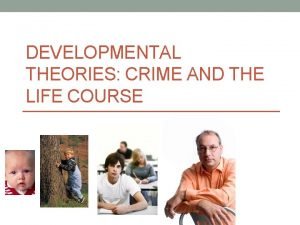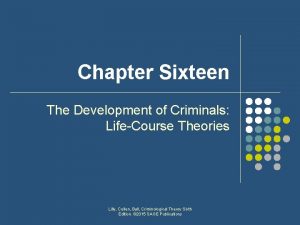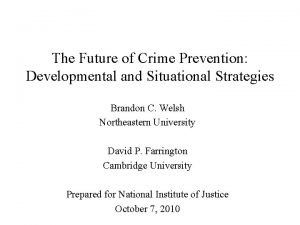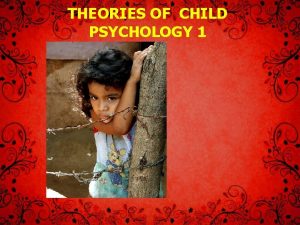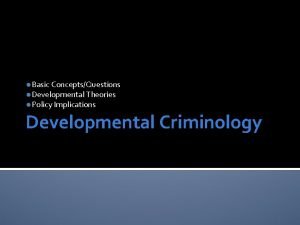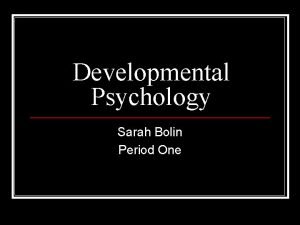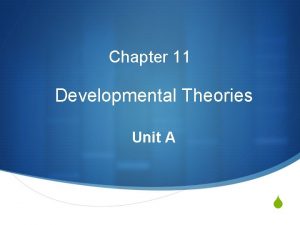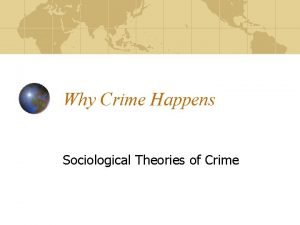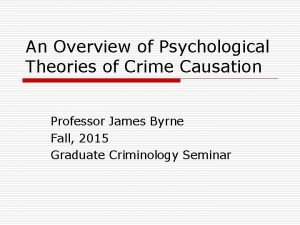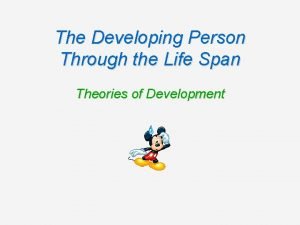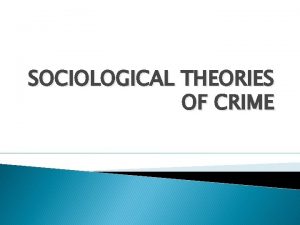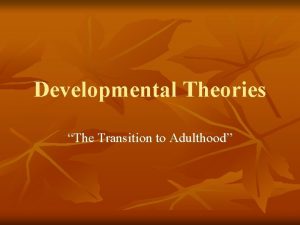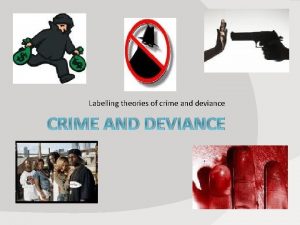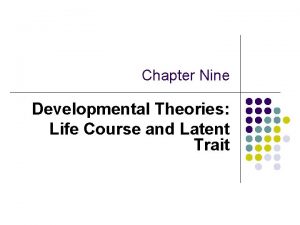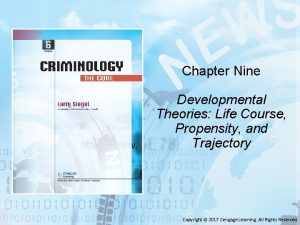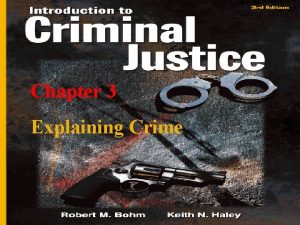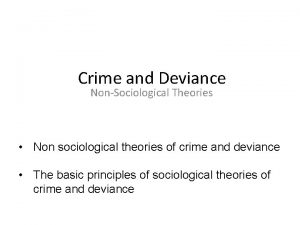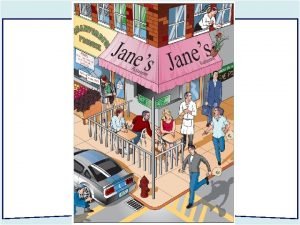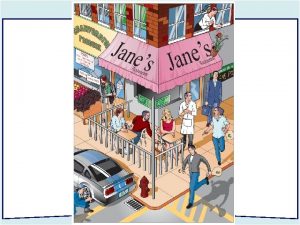DEVELOPMENTAL THEORIES CRIME AND THE LIFE COURSE Developmental













































- Slides: 45

DEVELOPMENTAL THEORIES: CRIME AND THE LIFE COURSE

Developmental Theories • Human personality and behavioral patterns emerge through a developmental process that unfolds from birth onward • What occurs early in life may shape what occurs later in life • Criminology had traditionally ignored the work on the life course • Focused on sociology and had little interest in how individuals developed over time • Rather, focused on what happens when an individual is placed in a certain social context

Developmental Theories • Developmental perspectives are dynamic • Studies whether an individual’s behavior remains stable or changes over time • Traditional criminological theories are static • • • Assumes contexts have stable and enduring effects on people caught in them Pay little attention to what occurs in childhood; rather, often focus on adolescence or adulthood This lack of focus on the childhood is probably due to two factors: 1. Participation in crime peaks in the teenage years (around 17 or 18), thus the relevance of childhood was not apparent • It made sense to ask about the teen/juvenile years 2. Studying juveniles was practical • Teens were an ideal population to investigate because it was easy to survey them in school and get self-report data

Developmental Theories • Most early research on adolescents was cross- sectional • Do not follow youth over time, but rather studies subjects at one point in time • Time- and cost-effective • Cannot consider factors that occur over time • Longitudinal research studies subjects over time • Can see how early events in life impact later life events • Difficult, requires teams of researchers, cost- and time-intensive

Glueck and Glueck’s Research • Some longitudinal research did occur and had a great impact • Sampson and Laub (1993) reexamined Glueck and Glueck’s (1950) matched sample study of 500 delinquent and 500 nondelinquent boys • White males ages 10 to 17 matched on age, race, neighborhood characteristics, and intelligence • Delinquents from two juvenile reformatories in Massachusetts and nondelinquents from Boston public schools • The Gluecks followed up with the boys at ages 25 and 32 • Sutherland attacked this work, saying it was atheoretical and downplayed sociological factors • Sociologists rejected the work, saying it was flawed methodologically and portrayed offenders as biologically deficient

Glueck and Glueck’s Research • • The Gluecks’ work showed the importance of highlighting the differences between delinquents and nondelinquents This research had three important contributions: 1. Embraced a multifactor approach where the causes of crime were driven by the data, not a single theory 2. Showed early antisocial behavior was related to later criminal behavior and thus criminal involvement was a dynamic developmental process • Good deal of stability from youth to early adulthood • Criminal involvement is developmental; what happens at one stage in life influences what happens at the next Showed antisocial youths not only are shaped by their circumstances but also impact the social world 3. • They are architects of their future and can knife off opportunities

Developmental (or Life Course) Theories • Relatively few youths suddenly become serious, chronic offenders during the juvenile years • A range of conduct problems arise during childhood • Childhood antisocial behavior is perhaps the strongest predictor of involvement in serious juvenile offending • Three theoretical implications: 1. Central causes of crime lie in childhood 2. Theories focusing on what happens in the teen years are incomplete, if not incorrect 3. Link between childhood and later deviance shows a dynamic developmental process

Developmental (or Life Course) Theories Developmental theories of crime attempt to explain why people develop into and out of crime • • They all tend to agree that childhood is a time during which a criminal trajectory starts, which they call onset • Also agree that some individual differences in the propensity for crime are established very early in the life course Use the term “heterogeneity” to describe how people vary in their orientation toward criminal conduct • Initial theories can be divided into three categories: • Theories of continuity 1. l Behavior is continuous and stable Theories of continuity or change 2. l Behavior is either continuous/stable or begins on one pathway and departs heading in an alternative direction Theories of continuity and change 3. l Behavior is continuous/stable but can also begin on one pathway and depart heading in an alternative direction

Theories of Continuity • Individual trait perspectives tend to be theories of continuity • Argue that once a trait emerges or becomes part of someone’s personality, this trait is hard to “get rid of” • The person carries the criminogenic trait across time and social contexts • Since the trait is enduring, the involvement in crime is also enduring • Sociological theories are implicitly continuity theories • Imply once a person is criminal, they remain criminal • Rarely address desistance; however some do (Sampson and Laub)

Gottfredson and Hirschi: A General Theory of Crime • Individual trait theories would have to explain how a crime -producing trait vanished to explain desistance • Most important theory of continuity is Gottfredson and Hirschi’s self-control theory • Published in A General Theory of Crime • A variety of a control theory • Suggests that an enduring propensity to commit crime, called self- control, emerges in childhood

Gottfredson and Hirschi: A General Theory of Crime • Link the failure to develop internal controls to the failure of parents to supervise their children, recognize deviant behavior, and punish and correct such conduct when it occurs • People with low self-control are impulsive, short- sighted, risk taking, nonverbal, and insensitive • Believe that once established, low self-control is highly resistant to being altered and this trait impacts people at every stage of their life

Gottfredson and Hirschi: A General Theory of Crime • This is a theory of continuity because it is argued that individuals can never escape from their low self-control • Self-control theory begins as a sociological theory but ends as an individual difference theory • Self-control is produced by parenting but, once established, self-control is set for life • Self-control theory is a rejection of Hirschi’s social bond theory • Argues weak social bonds and crime are caused by low self-control • Argue the age–crime curve is invariant across societies, but no theory has been developed to explain it • However, differences in crime tendencies across individuals remain relatively stable across the life course

Differences between Hirschi’s Two Theories Dimension of the Theory Gottfredson and Hirschi’s General Theory of Crime Hirschi’s Social Bond Theory Nature of control Self-control Social bonds Type of control Internal External (social): due to the quality of relationships to society Stability of control Established in childhood: individual differences in selfcontrol persist throughout life Control may change across life as the strength of the social bonds change Relationship of bonds to crime Quality of bonds and level of crime both caused by level of self -control Causes crime; quality of bonds determines level of crime

Theories of Continuity or Change • These theories argue there are two different pathways, with one marked with continuity and the other marked with change • Moffitt argues the peak of crime in the teenage years seen in the age–crime curve conceals two groups that take different developmental pathways into crime • Her two-group taxonomy includes: 1. Life-course-persistent offenders (LCPs) 2. Adolescence-limited offenders (ALs) • During adolescence, the age–crime curve peaks because both the LCPs and ALs are offending

Moffitt: “Pathways in the Life Course to Crime” • Life-course-persistent offenders start antisocial acts early and continue their waywardness into and beyond adolescence • Continuity is the hallmark of this group • Make up a small percentage of the population (roughly 5%) • Their antisocial behavior is stable from preschool to adulthood and across social contexts (e. g. , home, school, work, etc. ) • The underlying antisocial disposition remains the same, but its expression changes form as new social opportunities arise • Bite at age 4, skip school at age 10, steal at age 16, drugs at age 20, rob at age 30, etc. sell

Moffitt: “Pathways in the Life Course to Crime” • LCPs • The developmental process begins with neuropsychological deficits • Normal brain development is disrupted through pre- or postnatal exposure to drugs, poor nutrition, injury, exposure to toxins, lack of stimulation, etc. resulting in psychological deficits • Leads to high activity levels, irritability, poor self-control, low cognitive ability, etc. • Verbal and executive functions are particularly important and have been found to be associated with antisocial behavior across the life course • Verbal deficits affect listening, reading, problem solving, speech, writing, and memory • Executive functioning produces a compartmental learning • Includes inattention and impulsivity expressive disability

Moffitt: “Pathways in the Life Course to Crime” • Neuropsychological refers to anatomical structures and physiological processes within the nervous system that influence psychological characteristics such as temperament, behavioral development, and/or cognitive abilities • Neuropsychological deficits impact a child’s cognitive, motor, and/or personality development • Low birth weights and symptoms of brain dysfunction have been shown to be related to difficult temperaments at ages 1, 2, and 3 and other problems as the child ages (e. g. , overactivity, impulsivity, temper tantrums, poor attention, poor school performance), which is linked to even further antisocial behavior in the future

Moffitt: “Pathways in the Life Course to Crime” • These individual traits/neuropsychological deficits are linked to misconduct and social failure throughout life • Lock individuals into crime by the way they interact with the social environment to create disadvantage and ensnare individuals in an antisocial life • Often evoke harsh/erratic parenting (evocative interactions) because they are more difficult and have more deficits • Interpret ambiguous situations as hostile and people as having harmful intent (reactive interactions) • Select and create environments that support their deviant lifestyles (proactive interactions) • Research has shown they associate with, and even marry, deviant others

Moffitt: “Pathways in the Life Course to Crime” • On top of neuropsychological deficits, these children are often not born into intact, wealthy families • Rather, these vulnerable children are born into disadvantaged families • Often raised in criminogenic environments and see stability in aggression across generations • Parents and children resemble one another on temperament, personality, and cognitive abilities • Parents often lack the physical and psychological to handle a difficult child resources

Moffitt: “Pathways in the Life Course to Crime” Overall, individual deficits or traits produce stability of offending in LCPs in two interrelated ways: • By the traits constant, contemporary effects/consequences 1. • By the way the traits foster cumulative continuity 2. • • Carries the same underlying traits from childhood to adulthood By leading to lost opportunities, failures, and poor choices that prune away the options for change (snowball effect) Support found for both of these factors

Moffitt: “Pathways in the Life Course to Crime” There are two sources of continuity that narrow the options for change: • Failing to learn conventional prosocial behavior 1. Behavioral repertoires consist almost solely of antisocial behaviors Miss out on opportunities at each stage of development to acquire and practice prosocial alternatives • • Becoming ensnared in a deviant lifestyle by crime’s consequences 2. Often make irrevocable decisions that close off opportunities • • Teenage parenthood, drug/alcohol addiction, patchy work histories, time incarcerated • Labeled as “bad” and get a bad reputation • Interventions with LCPs have not been very successful • The theory of LCPs emphasizes the constant process of reciprocal interactions between personal traits and the environmental reactions to them

Moffitt: “Pathways in the Life Course to Crime” • Adolescence-limited offenders start and finish their criminality during the teenage years • Change or discontinuity is the hallmark of this group • Change is often abrupt, starting in adolescence and ending in early adulthood • This groups restricts their criminality to the teenage years • This is a very large group of individuals (almost all adolescents) • As youths enter adolescence, their developmental challenge is to overcome the maturity gap created by the mismatch between their adult biological development and modern society’s expectation that they refrain from adult behaviors for several years (e. g. , sexual activity, smoking, drinking) • This gap between social and biological maturity is their motivation for delinquency

Moffitt: “Pathways in the Life Course to Crime” • ALs • Motivation for delinquency is translated into social mimicry • Youth model/imitate the delinquent conduct of other adolescents, usually the LCPs in their own age cohort or older youths • Thus, during adolescence, LCPs often become popular because they are role models for the AL youth • ALs often offend in groups, while LCPs will offend alone • Delinquency is self-reinforcing in that it shows, symbolically, autonomy from adults and maturity • Seen as a statement of independence and maturity • Adulthood brings desistance • The maturity gap closes, adult conventional roles become available • Consequences of crime escalate and there is a decrease in the appeal and reinforcements of delinquency (e. g. , can lose job, spouse, kids, etc. )—commitment costs

Moffitt: “Pathways in the Life Course to Crime” • AL’s causal factors are proximate and specific to the period of adolescent development • Under reinforcement and punishment contingencies • Only act antisocially when it is instrumental • Lack consistency across situations (e. g. , home, school, with peers, etc. ) • Some ALs can become trapped into crime well into their adult years • Teen pregnancy, drug/alcohol addiction, incarceration, etc. • However, unlike their LCP counterparts, most ALs desist from crime • Thus, their antisocial behavior is characterized by discontinuity, or change, and is limited to their adolescent years • Exempt from contemporary consequences and cumulative continuity

Moffitt: “Pathways in the Life Course to Crime” Adolescents who do not engage in crime may not have: • Experienced the maturity gap 1. • Late puberty or early initiation into adult roles • Lack the motivation for experimenting with crime Had access to antisocial role models 2. • Fewer opportunities in rural than urban areas • Have personalities that make them unattractive to other teens • Tense, overcontrolled, lack personal skills, timid, etc.

Moffitt: “Pathways in the Life Course to Crime” • Although people have questioned whether or not there are more than two groups of offenders, research has shown support for Moffitt’s theory of life-course-persistent and adolescence-limited offenders

Theories of Continuity and Change • Sampson and Laub, using the Gluecks’ data, published two classic books, Crime in the Making and Shared Beginnings, Divergent Lives • Here is where they presented their age-graded social bond theory • Supplemented the Gluecks’ data by following up the sample until age 70 and interviewing 52 men • Argued pathways and turning points characterize a life course • Thus, there is both continuity and change in behavior

Laub and Sampson: “A Theory of Persistent Offending and Desistance from Crime” • Argue people can be caught in pathways or life trajectories that form a continuous line over time • May extend from childhood, and there is considerable evidence that antisocial behavior is relatively stable across the life course • But also argue there are turning points • Events in life that can change a life trajectory • Examples: marriage, work, and school

Laub and Sampson: “A Theory of Persistent Offending and Desistance from Crime” • A complex set of factors combine to entrench a child on an antisocial pathway • Individual differences (e. g. , difficult temperament, early conduct problems) • Disadvantaged environments (e. g. , unstable family life) • The above conditions foster ineffective and rejecting parenting, decrease the chances the child will do well in school, may lead to exposure to delinquent peers and siblings which may result in delinquent behavior • This weakens social bonds, which makes future delinquency and then adult crime more likely • This is a form of cumulative continuity where family, school, and work opportunities are “knifed off”

Laub and Sampson: “A Theory of Persistent Offending and Desistance from Crime” • However, people can get out of this criminal pathway • If an individual establishes conventional social bonds, this will lead to social control, and has the potential to change behavior • Social bonds can arise during childhood (e. g. , attachment to parents), adolescence (e. g. , ties to school), and adulthood (e. g. , marriage) • Change occurs when offenders acquire quality social bonds (e. g. , a good job or marriage)

Laub and Sampson: “A Theory of Persistent Offending and Desistance from Crime” Thus, fresh ties to conventional society may allow people to overcome their criminal propensities and divert them from crime • The same individual can experience both continuity and change in offending • Laub and Sampson found support for their theory • Following men up to age 70, they showed almost all men desisted from crime • • Argue that turning points (quality social bonds) lead to desistance by: 1. Knifing off the past from the present 2. Providing supervision, monitoring, and opportunities for social support and growth 3. Bring change in and structure to routine activities 4. Provide an opportunity for identity transformation

Laub and Sampson: “A Theory of Persistent Offending and Desistance from Crime” • Desistance happens by default • There is no conscious decision to stop being criminal; rather, they have invested so much in the marriage, job, parenthood, etc. that they do not want to risk losing it • However, desistance can involve human agency • People have some choice within their given social context or situation • Brings motivation back into theory • Can have some motivation to change within situational considerations • However, Laub and Sampson do not see this motivation as an enduring trait/orientation • Rather it is situational and emerges from person–environment interactions • This makes adult development unpredictable (unlike Moffitt’s theory) • Cannot determine at what point in life people will desist • Not a predictable, universal sequence of steps • Turning points are fortuitous events

Laub and Sampson: “A Theory of Persistent Offending and Desistance from Crime” • Persistent offenders are those who did not have quality social bonds or turning points • Their lives are marked with much marital, residential, and job instability, failure in school, and long periods of incarceration • Also in contact with others like them, which increases their offending

Laub and Sampson: “A Theory of Persistent Offending and Desistance from Crime” • Overall, offending is explained by individual differences, environmental differences, social interactions, and random, chance events • No set pathway, each individual is different and has a different life course of offending • These postulations have had support in the empirical research

Giordano et al. : “Cognitive Transformation and Desistence from Crime” • Most theories of crime are explanations of the onset and persistence of offending • Try to explain why some individuals, but not others, engage in crime • Giordano, Cernkovich, and Rudolph especially concentrate on desistence • Argue desistence is a dynamic, interactive process that involves both opportunities for change and active efforts to interpret the world and themselves differently • Two interrelated components are needed for desistence: 1. 2. Offenders must have opportunities to develop conventional ties to society Four interrelated cognitive transformations must occur

Giordano et al. : “Cognitive Transformation and Desistence from Crime” • Focus mainly on cognitive shifts that occur as an integral part of the desistance process • Differ from Sampson and Laub • Giordano et al. emphasize the actor’s own role in creatively and selectively appropriating elements in the environment such as a good spouse or job rather than these events being fortuitous • Call these hooks for change rather than turning points • The actor must latch onto these hooks • These opportunities serve as catalysts for lasting change when they energize fundamental shifts in identity and changes in the meaning and desirability of deviant/criminal behavior • Place a greater emphasis than Sampson and Laub on the actor’s own role

Giordano et al. : “Cognitive Transformation and Desistence from Crime” This viewpoint is useful for: • 1. Highlighting the important period when actors make initial attempts to veer off a deviant pathway 2. Accommodating the observation that quite a few individuals exposed to prosocial experiences fail to take advantage of them 3. Focusing on cognitive changes, rather than a small set of predictors

Giordano et al. : “Cognitive Transformation and Desistence from Crime” Argue cognitive shifts or four cognitive transformations must be present for desistance to occur • 1. The actor’s openness for change 2. Exposure to a hook for change 3. The actor’s ability to envision a replacement self 4. Transformation in how the actor views the deviant behavior or lifestyle itself

Giordano et al. : “Cognitive Transformation and Desistence from Crime” • General openness for change • Need to be open or believe that they can change • This is insufficient by itself for change • Exposure to hooks for change • Must have an opportunity to change • A fundamental premise is that both exposure to a hook and one’s attitude toward it are important elements of successful change • Must see the opportunity as a positive development and define the new state of affairs as incompatible with continued deviation

Giordano et al. : “Cognitive Transformation and Desistence from Crime” • Actor’s ability to envision a replacement self • This replacement self supplants the marginal one • Forms a new identity • Sees it as inappropriate for “someone like me” to engage in deviant behavior • Acts as a cognitive filter for decision making • The identity transformation potential of the hooks for change is present • This is different from the control aspect of turning points in Sampson and Laub’s theory

Giordano et al. : “Cognitive Transformation and Desistence from Crime” Transformation in how the actor views the deviant behavior or lifestyle itself • • The actor no longer sees the deviant behaviors he/she used to engage in as positive, viable, or even personally relevant • The process of desistence is complete at this stage

Giordano et al. : “Cognitive Transformation and Desistence from Crime” • The four cognitive transformations not only are related to one another but also inspire and direct behavior • Actions flow from these cognitive shifts that cannot be explained solely with references to predictor effects (e. g. , how the spouse controls the offender)

Giordano et al. : “Cognitive Transformation and Desistence from Crime” • Overall: • Argue that individuals vary in what they bring to the desistence process • Differences in preferences and levels of motivation • There is a dynamic interplay between the individual and catalysts for change which explains why some individuals exposed to a given catalyst fail to hook onto it • The hooks for change vary in their transformative potential • Successful hooks provide an actor with a detailed plan of action or a cognitive blueprint, often have a projective element directing the actor’s attention toward the future, and are associated with positive themes • Provide the actor with new definitions and replacement behaviors • More successful if provide a gateway to conforming others who can reinforce the actor’s initial forays into prosocial behavior

Giordano et al. : “Cognitive Transformation and Desistence from Crime” • Overall: • The individual has an important role in selecting adult friendships and romantic partners who have the potential to be good influences while knifing off undesirable companions • Argue their theory and Sampson and Laub’s can be integrated • Combine their ideas with Sampson and Laub’s focus on investment buildup • Highly invested actors develop a strong stake in conformity and do not want to jeopardize what they have accumulated • However, need to recognize that a minimum level of resources is needed to start the transformation process • Calling on the help of others can provide structure and guidance along the way • Over time the actors will have built up prosocial relationships, but will have come to enjoy the investing process as well • In turn, they will refrain from criminal behavior because they have much to lose and they look back on their prior deviant life with disdain • This leads to internalized control

Summary • Developmental theories are now very prominent and are taking a dominant role in the field • Their main proposition that crime is a dynamic process that potentially begins in childhood and occurs across the life course is indisputable • Some theories are theories of continuity (Gottfredson and Hirschi), while others are theories of continuity or change (Moffitt), while still others are theories of continuity and change (Sampson and Laub) • Theories, now, need to be able to address the onset, maintenance, and desistance of criminal behavior across the life course in order to be seen as thorough and viable theories
 Theories of human development
Theories of human development Life course theory crime
Life course theory crime Developmental crime prevention
Developmental crime prevention Age graded theory
Age graded theory Developmental stages theory
Developmental stages theory Developmental theories
Developmental theories Developmental theories
Developmental theories Sarah bolin
Sarah bolin Chapter 11 developmental theories
Chapter 11 developmental theories Sociological theories of crime
Sociological theories of crime Modern biological theories of crime
Modern biological theories of crime Psychological theories of crime
Psychological theories of crime 2106 crime scene investigation
2106 crime scene investigation Course title and course number
Course title and course number Half brick wall in stretcher bond
Half brick wall in stretcher bond Course interne course externe
Course interne course externe A systematic statement of principles and generalizations
A systematic statement of principles and generalizations Hình ảnh bộ gõ cơ thể búng tay
Hình ảnh bộ gõ cơ thể búng tay Ng-html
Ng-html Bổ thể
Bổ thể Tỉ lệ cơ thể trẻ em
Tỉ lệ cơ thể trẻ em Gấu đi như thế nào
Gấu đi như thế nào Chụp phim tư thế worms-breton
Chụp phim tư thế worms-breton Chúa yêu trần thế
Chúa yêu trần thế Môn thể thao bắt đầu bằng chữ đua
Môn thể thao bắt đầu bằng chữ đua Thế nào là hệ số cao nhất
Thế nào là hệ số cao nhất Các châu lục và đại dương trên thế giới
Các châu lục và đại dương trên thế giới Công của trọng lực
Công của trọng lực Trời xanh đây là của chúng ta thể thơ
Trời xanh đây là của chúng ta thể thơ Mật thư anh em như thể tay chân
Mật thư anh em như thể tay chân Phép trừ bù
Phép trừ bù độ dài liên kết
độ dài liên kết Các châu lục và đại dương trên thế giới
Các châu lục và đại dương trên thế giới Thể thơ truyền thống
Thể thơ truyền thống Quá trình desamine hóa có thể tạo ra
Quá trình desamine hóa có thể tạo ra Một số thể thơ truyền thống
Một số thể thơ truyền thống Bàn tay mà dây bẩn
Bàn tay mà dây bẩn Vẽ hình chiếu vuông góc của vật thể sau
Vẽ hình chiếu vuông góc của vật thể sau Thế nào là sự mỏi cơ
Thế nào là sự mỏi cơ đặc điểm cơ thể của người tối cổ
đặc điểm cơ thể của người tối cổ V cc cc
V cc cc Vẽ hình chiếu đứng bằng cạnh của vật thể
Vẽ hình chiếu đứng bằng cạnh của vật thể Vẽ hình chiếu vuông góc của vật thể sau
Vẽ hình chiếu vuông góc của vật thể sau Thẻ vin
Thẻ vin đại từ thay thế
đại từ thay thế điện thế nghỉ
điện thế nghỉ
